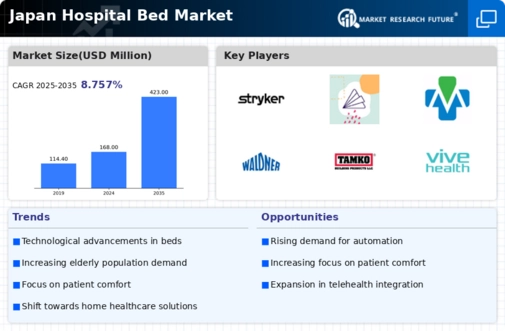Rising Healthcare Expenditure
The hospital bed market in Japan is experiencing growth due to the increasing healthcare expenditure. As the government allocates more funds to healthcare, hospitals are investing in advanced medical equipment, including hospital beds. In 2025, Japan's healthcare expenditure is projected to reach approximately $500 billion, reflecting a growth rate of around 3% annually. This financial commitment enables healthcare facilities to upgrade their infrastructure, ensuring that they can provide high-quality care. The hospital bed market industry benefits from this trend as hospitals seek to enhance patient comfort and safety through modern bed designs and technologies. Furthermore, the emphasis on improving healthcare services drives demand for specialized beds, such as those for intensive care units and rehabilitation, thereby expanding the market's scope.
Rising Incidence of Chronic Diseases
The increasing prevalence of chronic diseases in Japan is a significant factor influencing the hospital bed market. Conditions such as diabetes, cardiovascular diseases, and respiratory disorders require ongoing medical attention and often necessitate hospitalization. As the population ages, the incidence of these diseases is expected to rise, leading to a greater demand for hospital beds. The hospital bed market industry is likely to see a corresponding increase in the need for various types of beds, including those designed for long-term care and specialized treatments. In 2025, it is projected that the demand for hospital beds will grow by approximately 10%, driven by the need to accommodate patients with chronic conditions. This trend underscores the importance of adapting healthcare resources to meet the evolving needs of the population.
Technological Integration in Healthcare
The integration of technology into healthcare systems is a pivotal driver for the hospital bed market in Japan. Innovations such as smart beds equipped with monitoring systems and adjustable features are becoming increasingly prevalent. These beds not only enhance patient comfort but also improve safety and care efficiency. The hospital bed market industry is likely to see a surge in demand for these technologically advanced solutions, as hospitals aim to streamline operations and provide better patient outcomes. In 2025, it is estimated that the market for smart hospital beds could account for over 25% of total hospital bed sales in Japan. This trend indicates a shift towards more sophisticated healthcare environments, where technology plays a crucial role in patient management.
Increased Focus on Rehabilitation Services
The growing emphasis on rehabilitation services in Japan is significantly impacting the hospital bed market. As the population ages, there is a rising need for rehabilitation facilities that cater to patients recovering from surgeries or injuries. This shift is prompting hospitals to invest in specialized beds designed for rehabilitation purposes, which often include features such as adjustable height and mobility assistance. The hospital bed market industry is likely to expand as more healthcare providers recognize the importance of tailored rehabilitation solutions. In 2025, the demand for rehabilitation beds is expected to increase by approximately 15%, reflecting the broader trend of personalized patient care. This focus on rehabilitation not only enhances patient recovery but also drives innovation within the hospital bed market.
Government Initiatives for Healthcare Improvement
Government initiatives aimed at improving healthcare infrastructure in Japan are a crucial driver for the hospital bed market. Policies that promote the modernization of healthcare facilities encourage hospitals to upgrade their equipment, including hospital beds. The Japanese government has set ambitious targets for healthcare quality, which includes enhancing patient care environments. As a result, the hospital bed market industry is likely to benefit from increased funding and support for healthcare projects. In 2025, it is anticipated that government investments in healthcare will exceed $50 billion, with a portion allocated specifically for upgrading hospital facilities. This financial backing is expected to stimulate demand for high-quality hospital beds, thereby fostering market growth.


















Leave a Comment